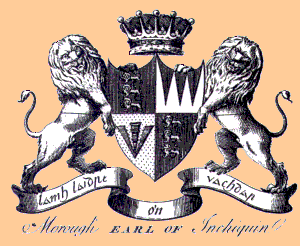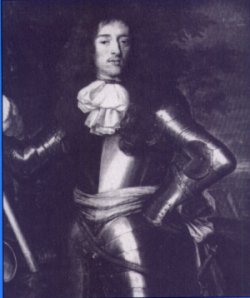|
|
 |
|
|
|
 |
 |
Murrough O'Brien
(The Tanist)
(1st Earl of Thomond &
6th Baron Inchiquin)
(Died 1551)
The Royalist:
Murrough the Burner, sixth Baron and first Earl of Inchiquin, was born an O'Brien. His father, the fifth Baron, was descended from the last king of Thomond who in 1543 had surrendered his crown to Henry VIII of England. For this he had received in compensation, the earldom of Thomond; his eldest son being created hereditary Baron of Inchiquin. When the west of Ireland was shired (divided into counties) in Queen Elizabeth's time, ancient Thomond disappeared; its territories had orighinally included all of County Clare to the west of the Shannon, and substantial parts of Counties Limerick and Tipperary on the left bank. Murrough could trace his ancestry back to the heroic Brian Boroimhe, who had been designated Ard-ri or High King of Ireland in A.D. 1002, but who had perished at the moment of his victory over the Danes of Dublin and their allies, the Irish of Leinster. Brian's death had occurred, at the end of the famous battle of Clontarf, on Good Friday 1014 when the Norse power in Ireland was finally defeated.
The Parliamentarian:
During the month of July 1644, Murrough changed his allegiance as regards the English war but not that of the Irish Protestants. He discovered from intercepted correspondence a conspiracy, headed by a Franciscan priest, Father Francis Matthews, to take over Cork, Kinsale and Youghal and to admit the Catholic army. Matthews was executed and Murrough decided to forcibly expel nearly all the Irish Catholics in his three principal towns. A fourth, Bandon, was almost exclusively Protestant and so no action was needed there. This expulsion was carried out ruthlessly. The goods and supplies left behind enabled Murrough to pay, feed and clothe his men for some months until Parliament should send aid. The Irish were only allowed to remove what they could carry on their persons, and so lost most of what they owned. The majority never recovered anything; certainly not during the Commonwealth, and precious little at the Restoration.
The King's Man:
By late 1649, even Lord Broghill was contemplating returning to the royalist fold as a result of the King's execution. Being much under Cromwell's influence, it took the latter's death and the passage of another decade before he did so, at which time he was rewarded with the Earldom of Orrery for his trouble. That summer, Ormonde advanced against Dublin while sending Murrough to attack Parliamentary garrisons elsewhere in the Pale. It was important to capture all these places before Cromwell could organise an expeditionary force for their relief. This he was known to be doing since he had been selected by Parliament in March for the command in Ireland; however, trouble at home with the Levellers had held him back. Murrough took Trim, Drogheda and Dundalk in quick succession. After wiping out its escort, he also captured an ammunition convoy on its way from Monck to O'Neill.
The Exile:
When they arrived in Paris, the exiled Lords Inchiquin and Ormonde found that their King was absent in Scotland but neither Charles II nor the Scots were enjoying much success. As might be expected, Murrough had plenty of enemies among the Catholics in exile, but Ormonde's support was enough to settle the King's mind in Murrough's favour. In May 1652, he was made a Privy Counsellor. This appointment met with the all-important approval of Charles's Lord Chancellor and principal adviser, Sir Edward Hyde. Hyde deemed Murrough 'a gallant gentleman of good parts, great industry, and of a temper fit to struggle with the affairs on all sides that we are to contend with'.
The Mercenenary:
After five years as Military Governor of french Catalonia, Murrough was given command of an expedition being sent by France to aid the Portuguese who were at that time asserting their historical independence from Spain. In 1580, this independence had been lost on the death of Henry the Cardinal, last Portuguese King of the House of Aviz. The throne had then been seized by Philip II of Spain, the most powerful of the various contenders. After Braganza who was proclaimed King Juan IV. Naturally France aided the Portuguese in her own war with Spain.
![]()
To learn more about 'Murrough O'Brien, (The Burner) by Ivar O'Brien please go to our O'Brien Book page.
The O'Brien Coat of Arms illustrated above is officially documented in Burke's General Armory. The original description of the arms (shield) is as follows:
"QUARTERLY, 1ST AND 4TH, GU. THREE LIONS PASS. GUARD. IN PALE PER PALE OR AND AR., 2ND, AR. THREE PILES MEETING IN POINT.; 3RD, OR, A PHEON AZ."
When translated, the blazon also describes the original colors of the O'Brien arms as:
"QUARTERED: 1 AND 4) RED, THREE LIONS WALKING, FACING FORWARD, PLACED ONE OVER THE OTHER, AND DIVIDED VERTICALLY GOLD AND SILVER; 2) SILVER, THREE RED PILES MEETING IN BASE; 3) GOLD, A BLUE ARROW."
Above the shield and helmet is the crest which described as:
"A BENT RIGHT ARM ISSUING OUT OF A CLOUD AND BRANDISHING A SWORD; ALL NATURALLY COLORED."
© The O'Brien Clan Since 1997 |